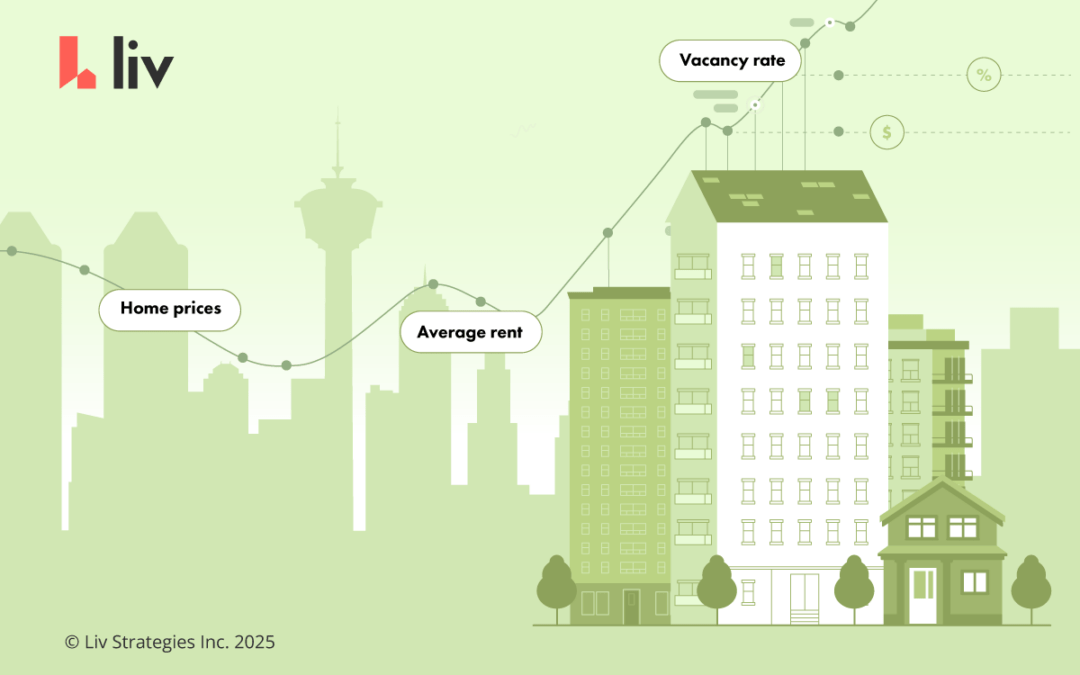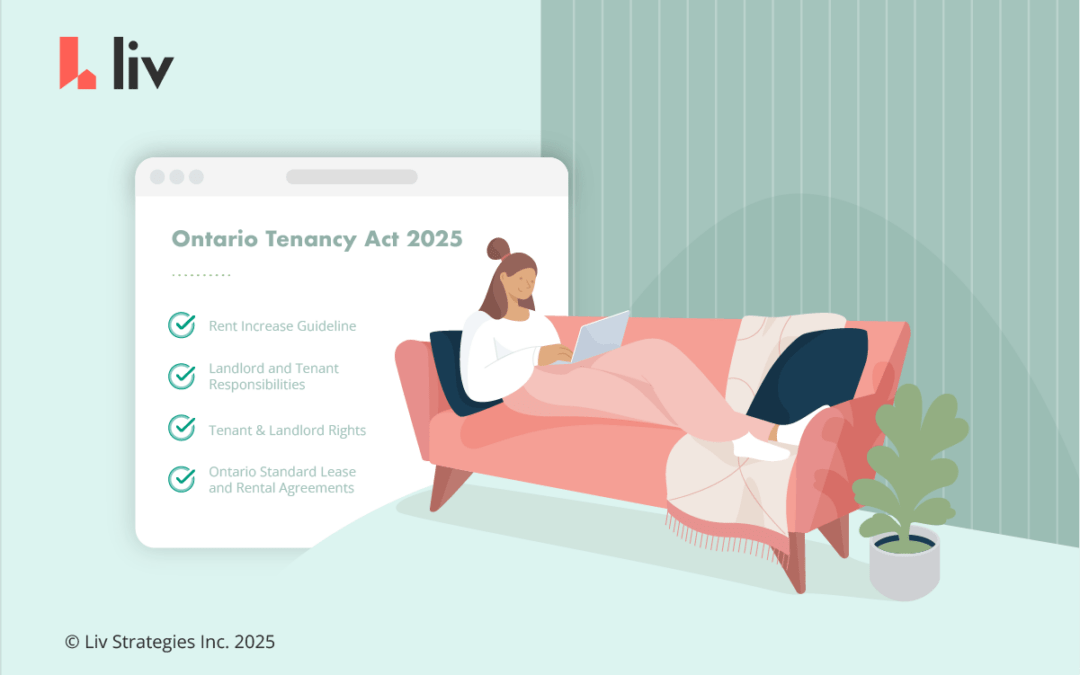While tariffs often dominate headlines in the context of trade wars and political disputes, their ripple effects can be felt much closer to home. In 2025, the renewed U.S. tariff on Canada is doing more than straining cross-border trade. It’s reshaping housing development, renovation timelines, and ultimately, rental prices in cities across the country.
Many of the goods affected by these tariffs, such as lumber, steel, and aluminum, are essential inputs for the construction industry. As prices for these materials rise, developers face steeper costs, which either delay projects or reduce the total number of new units being built. In turn, low rental supply and high demand are combining to push prices higher, especially in urban centres like Toronto, Vancouver, Calgary, and Montreal. This liv.rent blog will explore how the U.S. tariff on Canada is shaping the Canadian rental market, breaking down which regions are most affected, and what it means for both tenants and landlords in 2025 and beyond.
Rent your perfect home with liv.rent
Search houses, rooms, condos and apartments for rent. Chat instantly with verified landlords. Apply to multiple listings. Save your chat history & signed documents all on one platform.
Why U.S.-Canada tariffs matter to the Canada rental market
When most people think of tariffs, they imagine higher prices on imported goods or tensions between governments. However, in 2025, the ripple effects of the current U.S.-Canada tariff landscape are reaching much further than the usual headlines. These tariffs are beginning to shape one of the most essential aspects of daily life for Canadians, where and how they can afford to live.
New and extended tariffs on construction materials, including lumber, steel, aluminum, and other manufactured goods, are making it significantly more expensive to build and maintain housing in Canada. Developers now face higher upfront costs when planning new rental projects, while landlords are paying more for basic repairs, upgrades, and long-term maintenance. These additional costs often translate into slower construction timelines, cancelled projects, or reduced investment in the rental sector altogether.
As a result, the supply of rental housing is tightening, while demand remains high in nearly every major city. Renters may find fewer units available, and those that do hit the market are often more expensive due to the increased cost of development. These pressures, while not always visible on the surface, are directly tied to international trade policy, making it clear that economic decisions made in Washington and Ottawa are influencing rental affordability from coast to coast.
>> Read More: How To Negotiate Rent: 6 Steps That Save Tenants Money
How U.S.-Canada tariffs are affecting the Canada rental market in 2025
The renewed tariff policies between Canada and the United States are already making a measurable impact on the rental housing sector. From stalled developments to increased monthly rent, the effects are being felt across all levels of the market.
Rising construction costs
One of the most immediate and visible consequences of U.S.-Canada tariffs is the rising cost of building new rental housing. Tariffs on materials like softwood lumber, structural steel, aluminum siding, and prefabricated components have driven up the cost of construction at nearly every stage. For developers, this means a higher price per square foot, often putting planned builds over budget before construction even begins.
Reports from Statistics Canada show that the price index for construction materials has continued to rise in 2025, particularly in high-growth urban regions. When these material costs increase, developers often delay, scale down, or cancel projects entirely. In cities like Vancouver, Toronto, and Calgary, this compounds existing housing shortages and adds pressure to the already strained rental supply.
In some cases, developers may attempt to pass costs on to renters in the form of higher lease rates once the units are complete. In others, they may pivot away from purpose-built rental projects entirely, choosing instead to focus on luxury or for-sale units that offer higher returns. Either way, the cost burden ultimately filters down to the renter/buyer.
Renovation and maintenance getting more expensive
Tariffs are not only affecting new construction. They are also driving up the cost of maintaining and upgrading existing rental properties, especially for landlords who rely on materials imported from the U.S. Essential items such as drywall, copper piping, electrical fixtures, roofing materials, and HVAC components are all subject to higher tariffs or price volatility due to supply chain disruptions.
This is especially challenging for smaller property owners and independent landlords who do not have access to large bulk purchasing agreements. A renovation that might have cost $15,000 in previous years could now exceed $20,000 with no added improvements simply due to higher material and shipping costs.
When maintenance becomes more expensive, landlords may delay upgrades or opt for cheaper alternatives, which can affect tenant satisfaction and unit quality. In more extreme cases, necessary repairs may be postponed indefinitely, contributing to a decline in overall housing standards.
According to the Altus Group 2024 Canadian Construction Cost Guide, costs for residential renovations have risen significantly across all major Canadian markets, with material inflation playing a central role. These added pressures make it harder for landlords to keep up with property upkeep, further widening the gap between supply and demand.
Renters are feeling the pressure too
For renters across Canada, the effects of U.S.-Canada tariffs are showing up in the form of higher monthly rent, limited availability, and more competition for units. While renters may not see the direct connection between tariffs and their lease agreements, the rising cost of materials and slower pace of new construction are shrinking the overall supply of rental units, especially in high-demand cities.
When developers delay or cancel projects, fewer units are added to the market. At the same time, landlords facing steeper maintenance costs may choose to increase rent between tenants or during lease renewals to cover their expenses. As this pressure builds, tenants are forced to make difficult trade-offs, such as settling for smaller spaces, moving farther from city centres, or paying more for the same amenities.
The result is a market where tenants are paying more for less, and where affordability challenges are increasingly tied to global economic factors like tariffs and supply chain volatility.
Small and mid-sized landlords are most vulnerable
While large property management firms may be able to absorb rising costs and navigate tariff-related challenges through scale, small and mid-sized landlords are much more exposed. These landlords often operate with tighter budgets, and a single unexpected expense like a major appliance replacement or roof repair can significantly disrupt their financial stability.
Because they do not benefit from bulk pricing or long-term supply contracts, smaller landlords are directly impacted by tariff-inflated material costs. Items like water heaters, cabinetry, flooring, and appliances, many of which are either imported or rely on cross-border supply chains are now more expensive and harder to source. When maintenance costs increase and rent controls limit their ability to raise prices, smaller landlords are often left with few options.
Some may delay repairs, cut back on upgrades, or consider exiting the market entirely, selling their properties or converting them to short-term rentals that promise higher margins. According to data from Canada Mortgage and Housing Corporation (CMHC), small landlords have already been declining in number over the past several years. With added pressures from tariffs, that trend may accelerate in 2025.
As small landlords scale back or exit the market, renters lose access to flexible, community-based rental options. This reduces diversity in the housing ecosystem and makes the market more dependent on large corporate landlords, who may not offer the same level of personalization or affordability.
Renter behavior is already shifting
More renters are now choosing to stay in their current units longer rather than face rising prices in a tighter market. This reduces overall turnover, making it even harder for new renters to find available listings. In cities like Vancouver and Toronto, where vacancy rates are already extremely low, renters are also broadening their search areas, often looking to suburban or adjacent communities in hopes of finding more affordable options.
Shared housing and multi-generational living arrangements are also becoming more common, especially among younger renters and new immigrants. Instead of renting a one-bedroom unit solo, many are opting for roommates or co-living spaces to split costs. Some are even delaying household formation altogether, staying with family longer while saving for future moves.
These behavioural shifts, while practical in the short term, also signal deeper concerns about long-term rental accessibility. With tariffs adding yet another layer of complexity to an already stressed market, renters are making strategic and sometimes difficult choices just to keep pace.
What should renters and landlords do now?
With tariffs now adding pressure to Canada’s rental housing system, both renters and landlords need to adapt quickly. For renters, tracking monthly rental trends through platforms like liv.rent can offer key insights on where and when to rent. Locking in longer lease terms can help guard against short-term price spikes, and exploring shared housing or broader search areas may offer more affordable options.
For landlords, rising costs mean careful planning is essential. Completing maintenance or renovations sooner may help avoid further price increases, especially as tariffs continue to push material costs higher. Using digital tools like liv.rent to manage listings, leases, and communication can reduce administrative workload. It’s also worth reviewing available rebate or incentive programs for energy-efficient upgrades, which could help offset rising expenses.
In this new landscape, being proactive, cost-aware, and data-informed will be the key to navigating a more competitive and unpredictable rental market.
As the Canada rental market evolves, tariffs add another layer of complexity
Canada’s rental market is already navigating multiple challenges, including population growth, housing shortages, and tightening regulations. The reintroduction and expansion of U.S.-Canada tariffs add yet another variable that complicates how rental housing is built, maintained, and priced.
As tariffs affect the cost and availability of building materials, they have a direct impact on how many new rental units can be delivered each year. When combined with existing labour shortages, municipal permitting delays, and zoning constraints, the added cost pressure creates even greater friction within the rental supply pipeline.
At the same time, affordability remains a top concern for both renters and governments. Policies like rent controls and tenant protections are designed to help, but they don’t address the underlying cost pressures caused by global trade policies. This disconnect makes it harder for policymakers to respond quickly and effectively to emerging problems.
As a result, renters are caught between rising prices and limited options, while landlords struggle to manage expenses and make long-term investments. Tariffs may not be the only issue affecting the market, but they are an increasingly important part of the equation, especially in 2025.
How Canada’s rental market changes for the major cities
Tariffs are influencing rental markets across the country, but the impact looks different from city to city. In this section, we’ll take a closer look at how four key urban centres are being affected.
Calgary rental market
In 2025, Calgary continues to experience rapid population growth, driven in part by interprovincial migration and a relatively affordable cost of living compared to other major cities. However, with new residents arriving and construction costs climbing due to tariffs, the rental market is under increasing strain.
Average rent prices in Calgary have decreased steadily through the first half of the year, particularly for unfurnished one- two- and three-bedroom units thid may change with the introduction of tarrifs. The pace of new purpose-built rental construction has slowed as developers face tighter margins and rising material costs, making it harder to keep up with demand. Many landlords are also struggling to maintain or upgrade properties as renovation expenses grow, reducing overall unit quality in some areas.
Toronto rental market
Toronto’s rental market is already one of the most competitive in the country, and in 2025, U.S.-Canada tariffs are adding more pressure to an already stretched system. With construction materials becoming more expensive, developers are struggling to complete new builds on time and on budget. This has slowed the delivery of new purpose-built rentals across the GTA, even as population growth and immigration continue to fuel demand.
liv.rent data shows that average rent prices for both furnished and unfurnished units in Toronto remain among the highest in Canada, with one-bedroom unfurnished units regularly exceeding $2,300 per month. The added strain of rising input costs means fewer rental units are being added to the market, while existing landlords are more cautious about investing in upgrades or renovations.
Edmonton rental market
Edmonton has traditionally offered more stable rental pricing compared to other major Canadian cities. With tariffs pushing up the cost of building materials, many local developers may re-evaluating the feasibility of planned rental projects, while smaller landlords are reporting higher expenses for basic repairs and maintenance. However this does not seem to be the case at the moment as many Canadians flock to Edmonton in search of more affordable housing, the Edmonton housing makret remians strong.
While the effects may be more subtle than in cities like Toronto or Vancouver, tariff-driven pressures are building, and could significantly reshape Edmonton’s rental landscape in the years ahead. At the same time, Edmonton’s population is growing, and the city’s reputation for affordability is drawing more renters from across Alberta and beyond. This increasing demand, combined with a slower pace of new rental development, could gradually erode the price advantage Edmonton has historically offered.
Unlock exclusive insights into Canada’s rental market
Download the full 2025 Trend Report for insights on average rent prices, rental market comparisons, key market drivers, and a deep dive into landlord and renter perspectives on the current rental landscape.
Vancouver rental market
Vancouver’s rental market is already one of the most expensive in Canada, and in 2025, tariff-related cost increases are compounding existing challenges. With ongoing demand, limited land availability, and complex permitting processes, developers in the region were already facing slim margins. The added impact of tariffs on materials like lumber, steel, and aluminum may push many projects over budget or into delays.
Smaller landlords in Vancouver are especially vulnerable. Many may choose to delay upgrades or defer routine maintenance, due to high material prices and longer wait times for imported goods. Some may even convert long-term rentals into short-term units or selling entirely to avoid the financial burden moves that further reduce the availability of stable housing. However this practice has been made more difficlult with the introduction of recent legislation.
For renters, this means more competition, higher prices, and fewer choices, all within a market that was already difficult to navigate. Tariffs may not be the sole cause, but they are accelerating trends that are making Vancouver’s rental market even tougher in 2025.
Expert insight: What happens next in the Canada rental market
Looking ahead, industry experts agree that tariffs will continue to be a significant factor shaping the rental housing landscape, especially if material costs remain elevated throughout 2025. The long-term consequences depend heavily on how governments respond, both in terms of trade negotiations and housing policy support.
If tariffs remain in place, many developers are expected to scale back their construction pipelines, focusing only on projects with strong financial backing or higher margins. This would reduce the number of new rental units entering the market and make it even harder to meet demand in major cities.
At the same time, housing advocates are calling for greater government intervention, including tax relief or subsidies for developers and landlords who face rising costs due to tariffs. Without such support, affordability challenges are likely to worsen, especially for renters in already expensive markets.
In short, while tariffs alone won’t define the future of Canada’s rental housing sector, they are now an essential part of the conversation. From builders and policymakers to landlords and renters, every part of the housing system is being affected, and the next phase will depend on how quickly stakeholders can adapt to the new cost realities.
FAQ: Tariffs & the Canada rental market
How do U.S.-Canada tariffs affect the Canada rental market?
Tariffs raise the cost of construction materials such as steel, lumber, and aluminum, which makes building and maintaining rental housing more expensive. These higher costs lead to fewer new rental units, slower renovation timelines, and higher rent prices as developers and landlords pass costs down to tenants.
Are rental prices in Canada rising because of tariffs?
Tariffs are one of several factors contributing to rising rent prices in 2025. While not the only cause, they increase development and maintenance expenses, which adds pressure to an already limited rental supply. This results in higher prices, particularly in major cities where demand is highest.
Will government policy reduce the impact on the Canada rental market?
It’s possible. Governments may step in with subsidies, tax credits, or trade adjustments to help offset rising costs. However, as of now, there is limited direct support tied specifically to tariff-related construction impacts. Most responses are focused on broader housing affordability strategies.
Which cities are most affected by these tariff-driven changes?
Major urban centres like Toronto, Vancouver, Calgary, and Montreal are feeling the most pressure. These cities are experiencing high population growth and limited rental supply, making them more sensitive to rising construction and renovation costs linked to tariffs.

Rethink The Way You Rent
Not on liv.rent yet? Experience the ease of digital applications & contracts, verified tenants & landlords, virtual tours and more – all on one platform. Sign up for free or download the app.
Subscribe to receive the latest tenant & landlord tips and get notified about changes in the Canadian rental market.
>> Stay up-to-date on the average rent in Vancouver, Toronto and Montreal: Rent Reports.



![Integrations Guide for liv.rent Landlords & Property Managers [2026]](https://liv.rent/blog/wp-content/uploads/2025/12/2025.12_Liv.rent-Integrations-blog-header-1080x675.png)

0 Comments